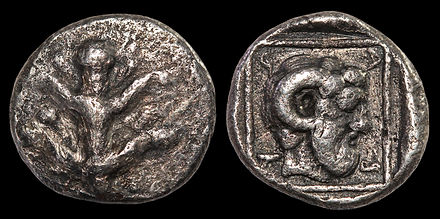
KYRENAICA, Barke. 480-450 BC. AR hemidrachm, 13 mm, 1.57 gm. Silphium plant / head of Zeus Ammon right within linear frame, B A P K around. Müller MAA 301. Very rare
This type of coin caught my eye a while back. At a glance, I thought the plant was equisetum. It's not; it is thought to be a now extinct plant called silphium. It may have belonged to the fennel family; it could be the extant plant Ferula tingitana. Reading about this plant furthered my resolve to find an numismatic example.
As luck would have it, these coins of North Africa are ridiculously expensive. I managed to find a well-priced although not very glamorous example in the recent Roma auction. It's pretty scratched up-- at best clumsily cleaned, at worst perhaps tooled. Still, given that I didn't want to pay a fortune for an example, I'm happy with it. Bonus-- it also shows Zeus Ammon, whose coin depictions I avidly collect!
Theophrastus (371-287 BC), mentions silphium several times in Historia Plantarum:
"In the Cyrenaica the cypress grows and the olives are fairest and the oil most abundant. Most special of all to this district is the silphium..."
He goes on to describe the physical characteristics and plant product preparation here and in the next three pages, noting that it grows wild and disappears upon cultivation of the land (although he further documents contradicting agricultural anecdotes). The plant appears to relatively new, or at least newly discovered: "The people of Cyrene say that the silphium appeared seven years before they founded their city; now they had lived there for about three hundred years before the archonship at Athens at Simonides."
Other online references mention legends that silphium was viewed as a gift from Apollo.
An article by Henry Koerper and A.L. Kolls, The Silphium Motif Adorning Ancient Libyan Coinage: Marketing a Medicinal Plant, has many interesting tidbits. It is available for downloading for $39.95 but you can get a free 5 minute peek. Here's the abstract:

List of uses of the silphium plant:
oral contraceptive and abortifacient
treatment for abdominal pain
treatment for alopecia
treatment for anal exrescences and prolapse
antidote for the poison of weapons, scorpion stings, snake bites
treatment of asthma, bronchitis, coughs, horseness
treatment of dog bites
treatment of bruises and wounds (external application)
a calefacient (warming) medicine
treatment for carbuncles, chillblains, callosities, and indurations
treatment of cardiac diseases
treatment for coeliacus
treatment of convulsions
corn and wart removal
promotion of digestion
as a diuretic
treatment of dropsy, jaundice, and other visceral affections including intestinal wounds
treatment of epilepsy
treatment of eye diseases
for gynecological problems (menstrual problems)
treatment for intestinal worms
as a liniment for lumbago and sciatica
treatment of mange
treatment of nervous disorders
treatment of opisthotonus
pain prevention
treatment of pleurisy
treatment of quartran fever (malaria?)
treatment of shivering
treatment of sinew affections (tendonitis?)
treatment of stomach colds (??)
treatment for tetanus
treatment for toothache
treatment for ulcers
treatment for inflammation of the uvula
as a vaginal suppository (for menstrual disorders?)
a veterinary medicine for sheep
Why did it become extinct? Speculative, but multifactoral: overharvesting due to exploitation of medicinal and veterinary uses. (Betcha it was really due to its reported aphrodisiacal qualities; some human behaviors never change.)
Pliny the Elder supposedly said that in Roman markets, silphium was worth its weight in silver denari. I could not find such a quote in Pliny's writings on silphium. However, he does mention that it supposedly acts as a soporific for sheep. Goats, not so much. They just go into fits of sneezing. [note to self: if I bring back silphium à la Jurassic Park, and if I decide to raise goats, keep them away from the silphium.]
By the first century CE, Silphium was quite scarce. The last reported sighting was a single stalk sent to emperor Nero "as a curiosity" (Pliny, Natural History, ch. 15)
Well, that's probably more than you wanted to know about silphium.
Gotta run... have to shop for groceries. I'm in the mood for braised fennel.
Location of Barke (#52 on the map; click map to go to the full interactive map of Greek coins in this collection)
